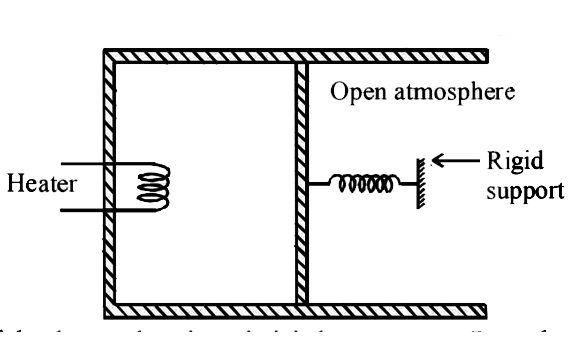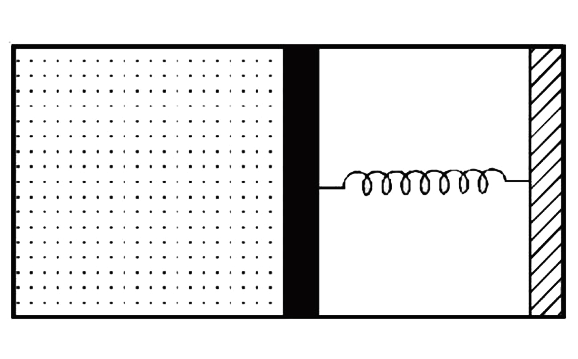An ideal monoatomic gas is confined in a cylinder by a spring loaded piston of cross-section 8×10−3m2. Initially the gas is at 300K and occupies a volume of 2.4×10−3m3 and the spring is in its relaxed (unstretched, uncompressed) state(see figure- 3.27). The gas is heated by a small electric heater until the piston moves out slowly by 0.1 m. Calculate the final temperature of the gas and the heat supplied (injoule) by the heater. The force constant of the spring is 8000 N/m, atmospheric pressure is 1×105N/m2. The cylinder and the piston are thermally insulated. The piston is massless and there is no friction between the piston and the cylinder. Neglect heat-loss through the lead wires of the heater.The heat-capacity of the heater coilis negligible.Assume the spring to be massless.

Initially, the pressure of the gas in the cylinder is atmospheric pressure as spring is in relaxed state. Therefore
P1 =atmospheric pressure =1.0×105N/m2
V1= initial volume =2.4×103m3
T1=initial temperature =300 K
When heat is supplied by the heater,the piston is compressed by 0.1m.The reaction force of compression of spring is equal to k x which acts on the piston or on the gas as
F=kx=8000 x 0.1 = 800 Nt
Pressure exerted on the piston by the spring
ΔP=FA=8008×10−3=1×105N/m2
The total pressure P2 of the gas inside cylinder is
P2=Patm+ΔP=1×105+1×105
=2×105N/m2
Since the piston has moved outwards, there has been an increase ΔV in the volume of the gas
ΔV=A×x=(8×10−3)×(0.1)
=8×10−4m3
The final volume of the gas
V2=V1+ΔV=2.4×10−3+8×10−4
=3.2×10−3m3
Let T2 be the final temperature of gas. Then
P1V1T1=P2V2T2
or T2=T1P2V2P1V1
=300×2×105×3.2×10−3105×2.4×10−3
=800 K
Let the heat supplied by the heater be Q. This is used in two parts: a part is used in doing external work W due to expansion of the gas and the other part is used in increasing the internal energy of the gas. Hence
Q=W+ΔU
Now W=∫V2V1PdV=∫x0(Patm+kxA)Adx [As pressure is (Patm+kx/A) and dV=A dx ]
or W=PatmAx+kx22
=[105×(8×10−3)(0.1)+8000×(0.1)22]
=120 joule
Further U=nCvΔT
Number of moles of gas can be obtained from initial conditions and gas law as
n=PVRT=1×105×2.4×10−38.314×300
=0.096 mole
Thus change in internal energy of gas is given as
ΔU=n(32R)ΔT [ As for monoatomic gas CV=32R]
or U=0.096×32×8.314×500=598.6 Joule
Heat supplied by heater
=120+598.6)
=718.6 joule
Topper's Solved these Questions
- THERMODYNAMICS LAWS & SPECIFIC HEATS OF GASES BOOK - PHYSICS GALAXY - ASHISH ARORACHAPTER - THERMODYNAMICS LAWS & SPECIFIC HEATS OF GASES EXERCISE - Discussion Question
17 Videos
- THERMODYNAMICS LAWS & SPECIFIC HEATS OF GASES BOOK - PHYSICS GALAXY - ASHISH ARORACHAPTER - THERMODYNAMICS LAWS & SPECIFIC HEATS OF GASES EXERCISE - Conceptual MCQs Single Option Correct
21 Videos
- PHOTOELECTRIC EFFECT AND MATTER WAVESBOOK - PHYSICS GALAXY - ASHISH ARORACHAPTER - PHOTOELECTRIC EFFECT AND MATTER WAVESEXERCISE - Unsolved numerical problems
42 Videos
- WAVE OPTICSBOOK - PHYSICS GALAXY - ASHISH ARORACHAPTER - WAVE OPTICSEXERCISE - Unsolved Numerical Problems
28 Videos
Similar Questions
An ideal monoatomic gas is confined in a cylinder by a spring-loaded piston of cross-section 8.0×10−3m2. Initially the gas is at 300K and occupies a volume of 2.4×10−3m3 and the spring is in its relaxed (unstretched, unompressed) state, fig. The gas is heated by a small electric heater until the piston moves out slowly by 0.1m. Calculate the final temperature of the gas and the heat supplied (in joules) by the heater. The force constant of the spring is 8000N/m, atmospheric pressure is 1.0×105Nm−2. The cylinder and the piston are thermally insulated. The piston is massless and there is no friction between the piston and the cylinder. Neglect heat loss through lead wires of the heater. The heat capacity of the heater coil is negligible. Assume the spring to be massless.

View SolutionAn ideal monoatomic gas is confined in a cylinder by a spring-loaded piston of cross-section 8.0×10−3m2. Initially the gas is at 300K and occupies a volume of 2.4×10−3m3 and the spring is in its relaxed (unstretched, unompressed) state, fig. The gas is heated by a small electric heater until the piston moves out slowly by 0.1m. Calculate the final temperature of the gas and the heat supplied (in joules) by the heater. The force constant of the spring is 8000N/m, atmospheric pressure is 1.0×105Nm−2. The cylinder and the piston are thermally insulated. The piston is massless and there is no friction between the piston and the cylinder. Neglect heat loss through lead wires of the heater. The heat capacity of the heater coil is negligible. Assume the spring to be massless.

View Solution
Knowledge Check
An ideal monoatomic gas is confined in a horizontal cylinder by a spring loaded piston (as shown in the figure). Initially the gas is at temperature T1, pressure P1 and volume V1and the spring is in its relaxed state. The gas is tehn heated very slowly to temperature T2,pressure P2and volume V2. During this process the piston moves out by a distance x. Ignoring the friction between the piston and the cylinder, the correct statement (s) is (are)
 AIf V2=2V1andT2=3T1, then the o the energy stored in the spiring is 14P1V1BIf V2=2V1andT2=3T1, then the change in internal energy is 3P1V1CIf V2=3V1andT2=4T1, then the work done by the gas is 73P1V1DIf V2=3V1andT2=4T1, then the heat supplied to the gas is 176P1V1
AIf V2=2V1andT2=3T1, then the o the energy stored in the spiring is 14P1V1BIf V2=2V1andT2=3T1, then the change in internal energy is 3P1V1CIf V2=3V1andT2=4T1, then the work done by the gas is 73P1V1DIf V2=3V1andT2=4T1, then the heat supplied to the gas is 176P1V1Two mole of an ideal monatomic gas are confined within a cylinder by a mass less spring loaded with a frictionless piston of negligible mass and crossectional area 4×10−3m2. The gas is heated by a heater for some time. During this time the gas expands and does 50J of work in moving the piston through a distance of 0.01m. The temperature of gas increases by 50k.

Heat supplied by heater during this process isA129.65JB1296.5JC12.96JD250J
An ideal monatomic gas is confined in a cylinder by a spring-loaded piston of cross-section 8.0×10−3m2. Initially the gas is at 300K and occupies a volume of 2.4×10−3m3 and the spring is in its relaxed (unstretched, unompressed) state, fig. The gas is heated by a small electric heater until the piston moves out slowly by 0.1m. Calculate the final temperature of the gas and the heat supplied (in joules) by the heater. The force constant of the spring is 8000N/m, atmospheric pressure is 1.0×105Nm−2. The cylinder and the piston are thermally insulated. The piston is massless and there is no friction between the piston and the cylinder. Neglect heat loss through lead wires of the heater. The heat capacity of the heater coil is negligible. Assume the spring to be massless.

View SolutionAn ideal monatonic gas is confined in a cylinder by a spring-loaded piston of cross section 8.0×10−3m2.initially the gas is at 300K and occupies a volume of 2.4×10−3m−3 and the sprinng is in its relaxed state. The gas is heated by a small heater until the piston moves out slowly by 0.1m. Calculate the final tenoerature of the gas. The force constant if the spring is 8000Nm−1,and the atmospheric pressure is 1.0×105Nm−2.Htecyl∈derandtheπs→narethermally∈sylated.Theπs→nandthespr∈garemass≤ssandthereisnoictionbetweentheπs→nandthecyl∈der.Neg≤ctanyheat−lossthroughthe≤adwiresoftheheater.Theheat∩acityoftheheatercoilis¬ligib≤.

View SolutionAn ideal monoatomic gas is confined in a horizontal cylinder by a spring loaded piston (as shown in the figure). Initially the gas is at temperature T1, pressure P1 and volume V1and the spring is in its relaxed state. The gas is then heated very slowly to temperature T2,pressure P2and volume V2. During this process the piston moves out by a distance x. Ignoring the friction between the piston and the cylinder, the correct statement (s) is (are)

View SolutionTwo moles of an ideal monoatomic gas are confined within a cylinder by a massless spring loaded with a frictionless piston of negligible mass and of cross-sectional area 4×10−3m2. The springis initially in its relaxed state. Now the gas is heated by a heater for some time. During this time the gas expands and does 50 J of work in moving the piston through a distance of 0.1 m. The temperature of the gas increases by 50 K. Calculate the spring constant and the heat supplied by the heater.
View SolutionTwo moles of an ideal monoatomic gas are confined within a cylinder by a massless and frictionless spring loaded piston of cross-sectional area 4×10−3m2. The spring is, initially in its relaxed state. Now the gas is heated by an electric heater, placed inside the cylinder, for some time. During this time, the gas expands and does 50J of work in moving the piston through a distance 0.10m. The temperature of the gas increases by 50K. Calculate the spring constant and the heat supplied by the heater. Patm=1×105N/m2R=8.314J/mol−K
View SolutionTwo moles of an ideal monoatomic gas are confined within a cylinder by a massless and frictionless spring loaded piston of cross-sectional area 4×10−3m2. The spring is, initially in its relaxed state. Now the gas is heated by an electric heater, placed inside the cylinder, for some time. During this time, the gas expands and does 50J of work in moving the piston through a distance 0.10m. The temperature of the gas increases by 50K. Calculate the spring constant and the heat supplied by the heater. Patm=1×105N/m2R=8.314J/mol−K
View Solution
